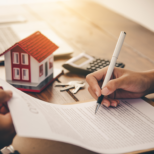
What is Conveyancing? 5 key stages of conveyancing explained.
19th May 2020 by John Munro
Conveyancing is essentially the process of transferring ownership of property from one person to another. However, to ensure that the recipient gets what they bargained for there is a lot of investigation into the history of the property to ensure that the legal ownership does not come with any nasty surprises.
There are 5 key stages to the Conveyancing process:
Stage 1 – Pre Contract
Once a sale has been agreed the seller’s conveyancer will put together a contract pack including a contract for the sale, various property information documents, and title deeds.
The buyer’s conveyancer’s job is to sift through this pack, raise enquiries with the seller’s conveyancer and also carry out searches of records relating to local authority issues, water and drainage, environmental considerations and more, to discover whether there are any potential problems for the buyer in owning or subsequently selling-on the property in future. If the buyer is using a mortgage to buy the property the conveyancer will also act for the lender to ensure that the property is good security for the lender’s loan and complies with the lender’s legal requirements.
Once the buyer’s conveyancer has completed the investigation and reported to the buyer’s satisfaction, the conveyancers will arrange for their clients to sign the necessary documentation and place them in funds in readiness for “exchange of contracts”.
Where one person’s purchase is dependent on another person buying their existing property there is a “chain”. The greater the number of links in the chain, the more likely statistically there is to be a problem in one of the links. For example, if the buyer at the bottom of the chain is delayed in obtaining a mortgage offer or if the conveyancer’s investigation shows up a defect which needs to be rectified before they can proceed there will be a delay in the whole chain reaching exchange of contracts, often to the frustration of everyone else in the chain.
Usually the last point to be agreed is the date when completion will take place and so it is advisable to start this dialogue with your estate agents fairly early in the process so they can contact all parties in the chain and endeavour to agree a completion which is convenient to all parties in the chain.
The pre-contract stage of conveyancing usually represents about 80% of the conveyancer’s work and 80% of the time from agreement to actual completion.
Stage 2 – Exchange of Contracts
“Exchange of contracts” is the point at which the buyer and seller become legally bound to buy or sell the property. Up until this point there is no binding agreement and any party can withdraw without having to pay any compensation to the other.
Once all parties in the chain are ready and willing to exchange contracts and have agreed on a completion date the conveyancers will bring the contracts into legal effect by following a strict legal formula which ensures that all parties in the chain become bound to buy or sell and complete their transactions on the same day.
At this point a deposit (usually 10%) is paid by the buyer to the seller’s conveyancer as security for the contract. If the buyer fails to complete in accordance with the contract this 10% deposit could potentially be forfeited to the seller. This is another reason why the buyer’s conveyancer has to have all their “ducks in a row” before exchanging contracts so as to ensure that the buyer is happy with what they are buying and will have funds to complete the purchase on the contractual completion date.
Stage 3 – Pre completion
In the period between exchange of contracts and completion the conveyancer will, if applicable, arrange for the mortgage funds to be sent in time for completion, and will arrange for all final documents and financial matters to be resolved so that completion can take place smoothly.
Buyers and sellers should make their arrangements for moving and packing up in readiness for completion.
Stage 4 – The Completion date
Or simply ‘moving day’!
This is the day when ownership of the property changes hands. The money moves up the chain and so if you are at the start of the chain then you are likely to complete early in the morning whereas if you are at the end of a chain you may not complete your purchase until later in the afternoon. Once completion has taken place the estate agents will release the keys to the new owner.
Stage 5 – Post Completion
As our clients settle into their new homes, the conveyancers still have some more work to do. The seller’s conveyancer will ensure the seller’s mortgage is paid off and the lender’s mortgage removed from the title documents. The buyer’s conveyancer will deal with payment of Stamp Duty land Tax to HM Revenue and Customs and will register the buyer’s title (and the new lender’s mortgage if applicable) at HM Land Registry.
How long will the process take?
This is a difficult question to answer as there can be so many variables. Every transaction and every chain is different and throws up different challenges. We understand the frustration that can arise once a sale has been agreed and the conveyancing process just seems to get in the way of the buyer and seller getting what they have agreed. However, it is important to ensure that everything is in legal order before parting with considerable sums of money. Part of our job is to explain and re-assure our clients as to the progression of their particular transaction. Client satisfaction is our number one priority which is borne out in our mission statement: “What matters to our clients matters to us.” All of our conveyancers ensure that this is at the forefront of everything we do and here is what just a couple of our clients have been kind enough to feed back to us:
“Top service, I have used Laceys twice for buying a house and they are superb. Always deliver on their promises. Very friendly and supportive service. would always recommend them to others.” Carl Lundquist
“We were kept informed of progress on a regular basis and did not have to chase for information at any stage.” Steve Mant
Contact us
If you are thinking of buying or selling a property and you would like to speak to one of our expert conveyancing lawyers, please contact Kelly Howe on k.howe@laceyssolicitors.co.uk or 01202 377800.



